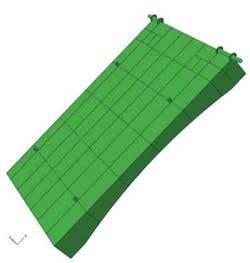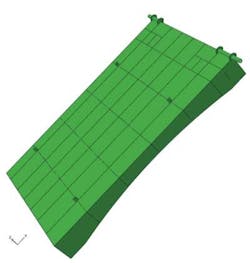Buckling analysis optimizes mudmat design
Nick O’Donohoe
Technology Writer
When seabed soil is too soft to bear the load of subsea structures such as PLETs and PLEMs, mudmats are designed and installed to provide additional support. The commonly used plate mudmats, often made with carbon steel, consist of a top plate and a number of perpendicular vertical stiffeners that function as load-bearing beams. But the simplicity of the design belies their importance.
“Mudmats are just as vital as the subsea equipment resting on them,” says Dr. Jinming Xu, offshore engineer at Foster Wheeler Upstream. “They must be designed to have sufficient strength, particularly buckling strength, and that requires considerable design analysis.”
Since most mudmats are custom-designed for individual load performances, subsea soil properties, and installation requirements, nearly every mudmat requires its own unique stress and buckling analysis. The analysis process used to be largely manual, time-consuming, and unwieldy—until engineers at Foster Wheeler created a software program, Mudmatician, for plate mudmat design, and integrated it tightly with Abaqus Unified Finite Element Analysis (FEA) software from SIMULIA, the Dassault Systèmes brand for realistic simulation. The result is an automated process that cuts analysis time from weeks to days and significantly reduces the potential for human error in hand calculation.
Number crunching
Under the old method, designers first obtained panel stresses (checking von Mises stress against the yield stress) directly from an Abaqus FEA. Then they perform buckling checks (determining panel strength against sudden failure due to buckling) by hand, based on the stresses derived from the analysis at the first step and using industry codes such as API Bulletin 2V to guide the buckling calculation and verification.
Mudmatician generated models of mudmats (non-plate accessories added manually), showing the mat top at top and the bottom at bottom
To check a single panel, they extract normal and shear stresses at nine different locations based on the panel aspect ratio (length to width). These 27 stresses then plug into a long list of complex if-then-else equations that varied with the stress values. To properly identify the panels, as well as the stresses at the correct location on each panel, designers hand-enter a code for each node and element number.
“The manual intensity of the analysis process made it excessively cumbersome,” says Xu, “and like all manual data entry, it could be prone to human error.”
Also, it was too time-consuming to permit much design modification and iteration, especially given the importance of meeting tight deadlines in the offshore oil and gas industry.
Taking a load off
The application programming interfaces (APIs) within Abaqus software helped engineers at Foster Wheeler develop their Mudmatician software.
“Abaqus has very good APIs for customized development,” Xu says. “It allowed us to write software that let us work with either the geometrical Abaqus model itself or the results in the output database. That’s a great advantage, and it enabled us to automate the analyses from finite element model development to post-processing and panel-wise buckling assessment.”
A single mudmat with 27 normal and shear stresses defined at nine locations.
This automated design cycle involves four steps:
- 1 The designer specifies a series of pre-designed mudmat parameters (size, stiffener layout, etc.) and creates a Python script design file.
- 2 The file then runs in Mudmatician, which follows the parameters and generates a meshed model for use in Abaqus/Standard. The model uses spring elements to capture the load-bearing behavior of subsea soil. Model sizes may vary from 10,000 to 100,000 elements.
- 3 The designer adds boundary conditions and loads based on subsea soil properties and load points for equipment (and, in some cases, by lifting points such as padeyes or trunnions). A Python script transfers the data into Abaqus. The FEA software analyzes the mudmat design to determine panel stresses.
- 4 Once the analysis is complete, Mudmatician is used as a post-processor to extract panel stresses (again, via a Python script) from the Abaqus output database. Mudmatician also performs a buckling check based on the industry code implemented in the software. Although it involves normal and shear stresses at nine different locations per panel, the buckling check is performed only at a few weak points, namely the center of the panel for the top panels, and the center of the panel and the middle of the free edge for the vertical panels.
During this process, Mudmatician also reads the design file to identify each panel. After each buckling check, results are expressed as utilization factors, the ratios determining whether buckling strength is within acceptable levels. Being less than unity means the panel is within the limit, but greater than unity denotes buckling inadequacy.
When the last step is finished, the designer can evaluate the overall integrity of the mudmat. If the strength seems insufficient or overly conservative, the engineer can return to the first step and quickly analyze a re-designed mudmat.
Remodeling is easy and involves changing one or more parameters in the design file to build a new model with Mudmatician, and re-running the FEA and the buckling check. This helps designers identify and reduce the likelihood of potential weak points in the mudmat.
Mudmatician output of mudmat buckling checks based on stress analysis results from Abaqus FEA. The utilization factors are shown as a discrete field “B” in contour. Each factor is shown right at the point (element) where it is calculated. The color represents the value of the utilization factor – least in blue and greatest in red. As shown, some panels with utilization factor(s) greater than unity are over the buckling limit
To validate the new technique, the engineers benchmarked Mudmatician analyses against existing manually designed mudmats and compared the results. The correlation was good, and the first mudmat designed entirely with Mudmatician is now complete.
“The amount of man-hours spent on the design using Mudmatician was dramatically reduced,” says Xu. “What once took weeks or even months now only takes days. That gives us the freedom to re-design if necessary, while meeting tight deadlines.”
In one case, the new, automated analysis path enabled Foster Wheeler Upstream to offer emergency services to a client who requested an extremely rapid mudmat design for an urgent project.
“We wouldn’t have been able to help them so quickly without Mudmatician and Abaqus,” Xu says.
“Together, Mudmaticianand Abaqus have streamlined our analyses and shortened our design process,” Xu says. “With improved engineering efficiency and design modification, it is now much easier to optimize mudmats. This allows us to deliver the highest-quality mudmat designs to our clients, quickly.”
Offshore Articles Archives
View Oil and Gas Articles on PennEnergy.com


